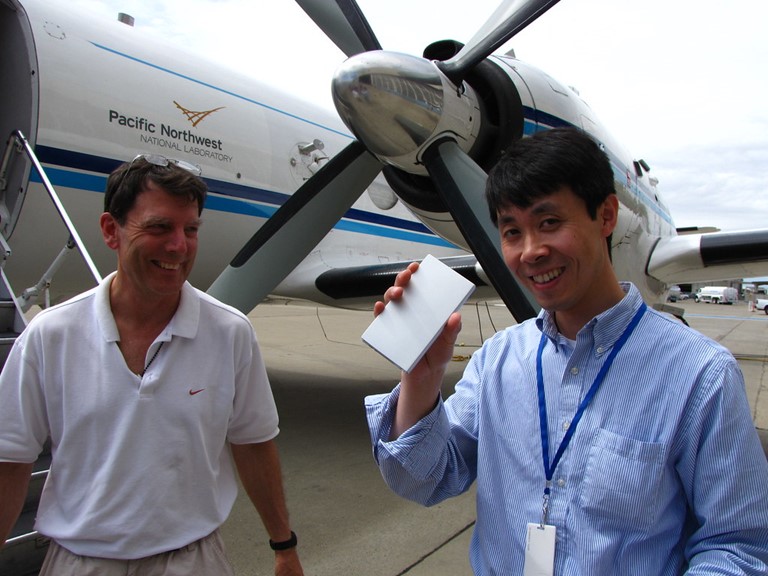
A researcher at Washington University in St. Louis studies aerosols in the atmosphere over remote ocean tracts, cities, and rural land
Atmospheric scientist Jian Wang, a professor and researcher at Washington University in St. Louis, has made a life’s study of aerosols, the mighty mites of the atmosphere.
These tiny particles of solid or liquid, suspended in the air above us, influence big processes. They help form clouds, make precipitation possible, and scatter or absorb sunlight in ways that influence Earth’s energy budget.
Despite their outsize atmospheric roles, aerosols can be vanishingly small―about the size of a DNA molecule (a few nanometers across). Or coarsely large, in particle terms―the width of a human hair (tens of microns wide).
Aerosols come from natural sources, including dust, sea spray, and bits of plant matter. They also originate from sources linked to human activity. Those include the carbon-rich byproducts of industry, transportation, and agricultural burns.
Wang has studied atmospheric aerosols of every kind―big or little, over land and sea. Predominantly, of late, he and his team investigate the elusive properties of aerosols that occur over ocean surfaces.
Marine Low Clouds
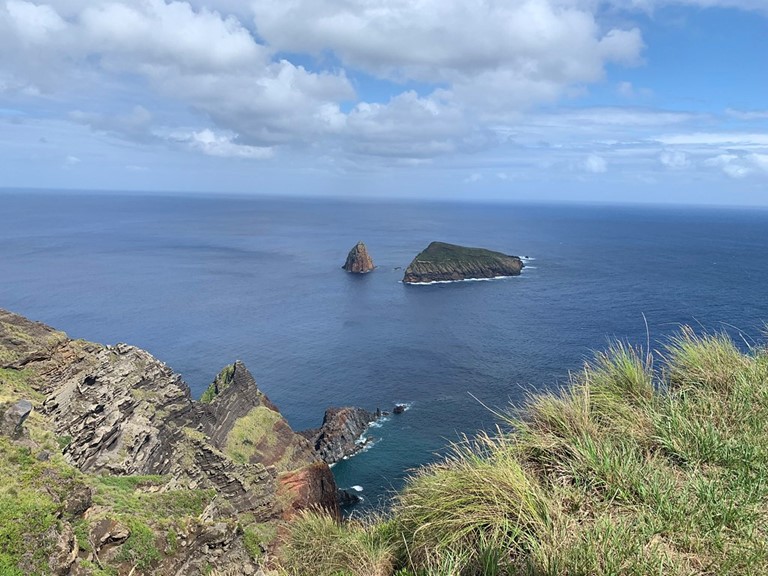
With marine boundary layers as a backdrop, Wang and his team have devoted much of their research in the last several years to aerosols within hard-to-study remote ocean regions.
Low clouds predominate in such places. They are mostly stratocumulus and can form vast decks hundreds of miles long. Marine low clouds strongly influence the global climate, in part, because of their sheer predominance and their ocean-shading properties.
One factor in faraway ocean regions gets special attention from Wang: cloud condensation nuclei (CCN), a subset of particles sufficiently large to form cloud droplets.
Nearly half of CCN start as nanometer-size clusters in the atmosphere, created from gaseous molecules in a process called new particle formation. During condensational growth, such clusters get large enough to form clouds.
Over remote oceans, however, CCN concentrations are quite low. This means marine clouds have fewer droplets than most other types, which tend to be thicker.
Having few CCN also makes marine low clouds more sensitive to changes in aerosol concentrations. All this intrigues Wang and his team.
A New-Particle Breakthrough
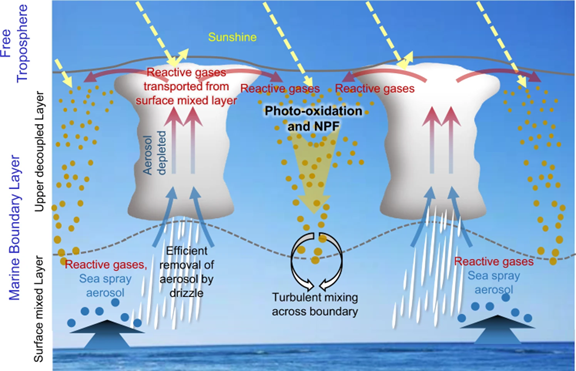
Until recently, scientists thought new particle formation was rare in remote marine boundary layers. Wang says their reasoning was that abundant sea-salt particles scavenge gas-phase molecules so avidly that few survive to form new particles.
But a January 2021 paper in Nature Communications, he and others present clear observational evidence that such particle formation is, as they write, “regular and frequent” in the upper part of the boundary layer.
Where clouds are broken in a marine boundary layer, new particles form in the clear regions between clouds. Reactive gases there rise into the upper troposphere, producing nucleation precursors. From there, turbulence mixes new particles downward to the surface.
These new cloud-seeding particles, previously undocumented, likely originate from organic compounds linked to biological activity at the sea-air interface. As the authors of the paper wrote, it is as if clouds in vast stretches of open ocean are seeded from “next to nothingness.”
This surprising finding was foreshadowed by a 2020 study for which Wang was the corresponding author.
Work for both papers was funded by the Atmospheric System Research (ASR) program at the U.S. Department of Energy (DOE).
ACE-ENA and TRACER
ASR and DOE have been drumbeats in Wang’s research for the last few years.
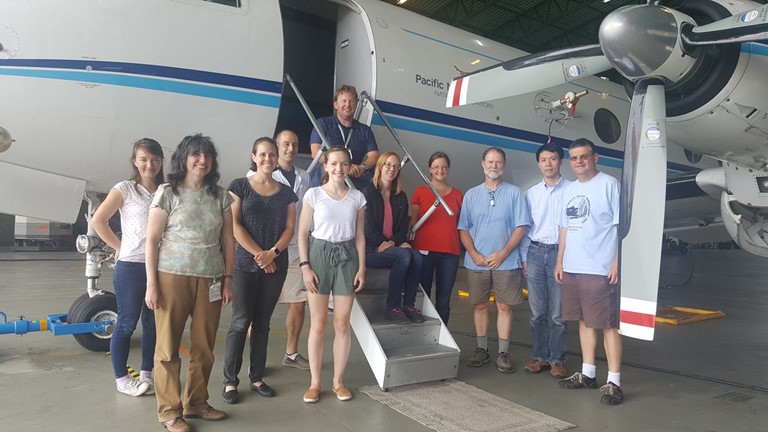
A 2019―2022 ASR project on aerosols in the marine boundary layer funded the work on cloud-seeding particles reported in the 2021 Nature Communications paper. Data were from a 12-month DOE field campaign that Wang led in 2017―2018: Aerosol and Cloud Experiments in the Eastern North Atlantic (ACE-ENA).
Surface instruments based on Graciosa Island in the Azores played a big part, along with instruments mounted on a piloted aircraft.
ACE-ENA prompted an ASR-funded follow-up field campaign led by Tim Bertram at the University of Wisconsin-Madison. In the spring and summer of 2022, researchers in Aerosol Growth in the Eastern North Atlantic (AGENA) identified precursors of the organic compounds likely contributing to new particle formation.
“We don’t have the answer yet,” says Wang. “But it seems that organics play a very important role.”
A second ASR project of his, slated for 2020―2023, investigates aerosol properties associated with convective clouds in a stormy coastal environment. Data comes from the TRacking Aerosol Convection Interactions ExpeRiment (TRACER), a yearlong field campaign in the Houston, Texas, region. Observations ended on September 30, 2022.

In July and August 2022, TRACER-CCN researchers investigated cloud condensation nuclei activity. Of special interest to them was the hygroscopicity of aerosol particles―that is, the degree to which they take up and retain water.
ARM Aid
Both ACE-ENA and TRACER relied on funding and core instruments from another research drumbeat in Wang’s life: DOE’s Atmospheric Radiation Measurement (ARM) user facility. ARM maintains three mobile and three fixed observatories across the world.
“For a number of years, (ENA) has provided some good context on aerosols and clouds. But in order to have a better understanding of (aerosol-cloud) processes, we needed measurements beyond those at the surface alone.”
― Jian Wang
One of the user facility’s permanent sites, the Eastern North Atlantic (ENA) atmospheric observatory, is on Graciosa. It lent its name to ACE-ENA. For TRACER, the first ARM Mobile Facility (AMF1) was in place at the campaign’s main site in La Porte, Texas.
For Wang and his team, of course, TRACER papers are months or more off. Published studies coming out of ACE-ENA, however, are already numerous.
One is a comprehensive overview paper Wang led in early 2022, which outlines the core reasons for the campaign: that marine low clouds in remote regions are poorly represented in global climate models. And that the response of such clouds to greenhouse gases and aerosols is a big source of uncertainty in models.
“For a number of years, (ENA) has provided some good context on aerosols and clouds,” says Wang. “But in order to have a better understanding of (aerosol-cloud) processes, we needed measurements beyond those at the surface alone.”
ACE-ENA researchers, for instance, used piloted aircraft to collect uniquely precise data on factors such as the CCN budget in marine low clouds, the microphysics of drizzle, and aerosol impacts on clouds and precipitation.
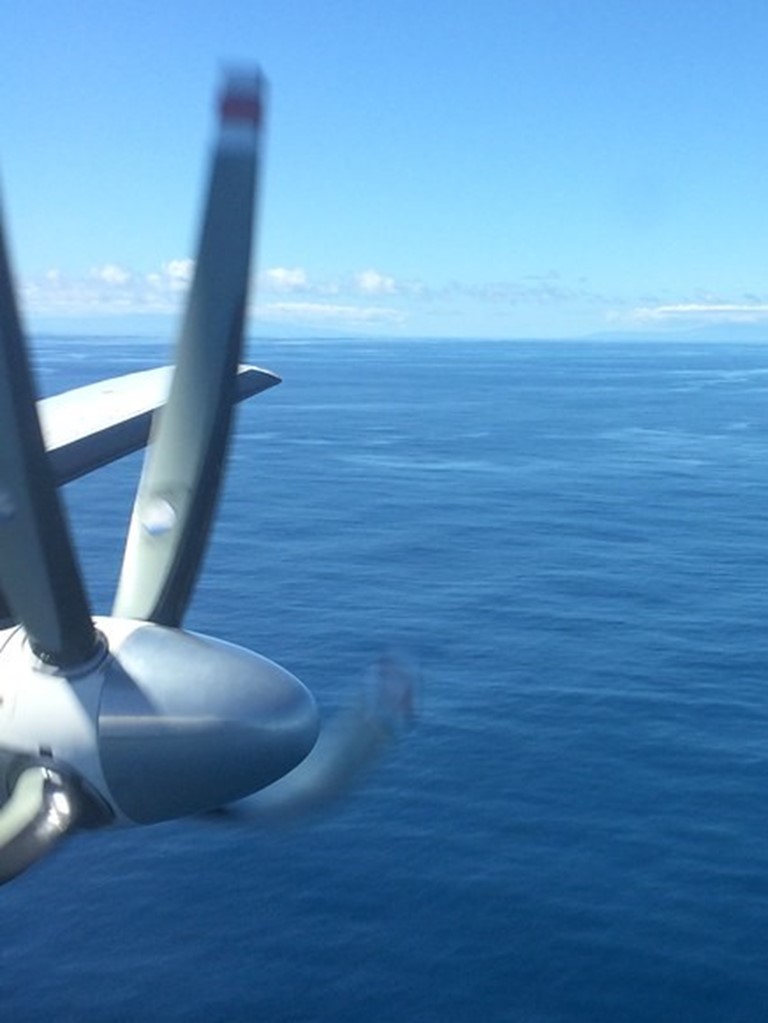
Taking to the Air
Measurements from research aircraft during ACE-ENA, says Wang, were vital to closing marine-aerosol knowledge gaps. Going airborne allowed researchers to map vertical profiles of how aerosols evolved. That included locations where clear air surrounded by broken clouds allows new particles to form.
When such processes occur at higher altitudes, “it’s an aircraft measurement that allows us to clearly see,” says Wang. “These types of processes would be hard to investigate from just ground measurements.”
Airborne deployments with an ARM research aircraft took place in June and July of 2017 and in January and February of 2018. Collectively, the flights netted about 160 hours of data.
But the ultimate beauty of ACE-ENA was combinatory and synergistic. ACE-ENA data researchers can tap both long-term data from ground instruments and intensive measurements from aircraft flying over the ocean itself.
It was a strategy, says Wang, “that worked well.”
Urban Climate Science
Wang’s Houston-area aerosol work during TRACER was a warm-up for his next city-climate adventure: a project called Community Research on Climate and Urban Science (CROCUS), based in the Chicago region. This Urban Integrated Field Laboratory (Urban IFL) is one of four tapped for DOE funding in the fall of 2022. The other Urban IFLs are in Phoenix, Arizona; on the southeast Gulf Coast of Texas near Port Arthur and Beaumont; and in Baltimore, Maryland.
Over five years, Wang will play a research role in CROCUS as part of an effort led by Argonne National Laboratory. The mission, with university and community partners, is to develop a blueprint for addressing urban climate change.
“My group and I are very much looking forward to it,” says Wang, starting with a CROCUS kick-off meeting in November.
Part of his team’s effort will be to map the heterogeneity of aerosols in the Chicago region, including the impact of the city core’s heat-island effect.
“Just the prospect of entering into an environment like that is exciting,” says Wang.
He envisions setting up instrumented fixed sites and van- or trailer-mounted mobile instrument platforms. The idea is to capture the spatial distribution of aerosol properties.
Far and Wide
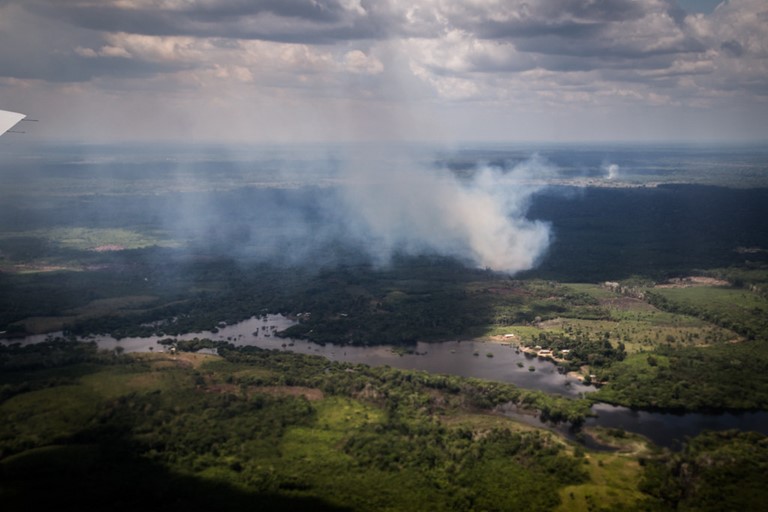
Chicago will hardly be the most exotic locale Wang has visited to pursue his aerosols work. There were the Azores, of course, for ACE-ENA―a campaign that continues to dominate his publications output.
Then there was the Observations and Modeling of the Green Ocean Amazon 2014―2015 (GOAmazon2014/15) ARM field campaign, led by Harvard University’s Scot Martin. It took researchers to pristine Amazonia in Brazil, as well as to investigations of urban and industrial influences within the rainforest. (Wang was a co-principal investigator.)
One of Wang’s most recent co-authored papers, from 2022, on anthropogenic organic nanoparticles, reaches all the way back to that fieldwork in the Amazon.
Using data from the same rainforest campaign, he also led an influential 2016 paper in Nature. It showed how small aerosol particles are sustained in the boundary layer when precipitation and strong downdrafts transport them from the free troposphere.
In 2013, Wang joined an ARM field campaign euphoniously called BBOP, short for the Biomass Burning Observation Project, and was later part of a landmark 2019 paper in Proceedings of the National Academy of Sciences on spherical tarball particles.
In 2010, Wang was in the Sacramento, California, area for the Carbonaceous Aerosol and Radiative Effects Study (CARES). It investigated carbon-based aerosols within an urban plume of pollution.
Even earlier in his career, in 2006, Wang took part in MILAGRO―the Megacity Initiative: Local and Global Research Observations project in Mexico City. DOE and ARM played a role.
The ‘Cool’ of Aerosols
An avid chemistry experimenter in high school, Wang went on to train in physical chemistry at the University of Science and Technology of China (B.S., 1996). When he arrived at the California Institute of Technology (M.S. 1998, PhD 2003), Wang was open to new frontiers, including chemically complex aerosols.
“I thought they were cool,” he says.
Wang worked chiefly with two Caltech mentors during his PhD studies.
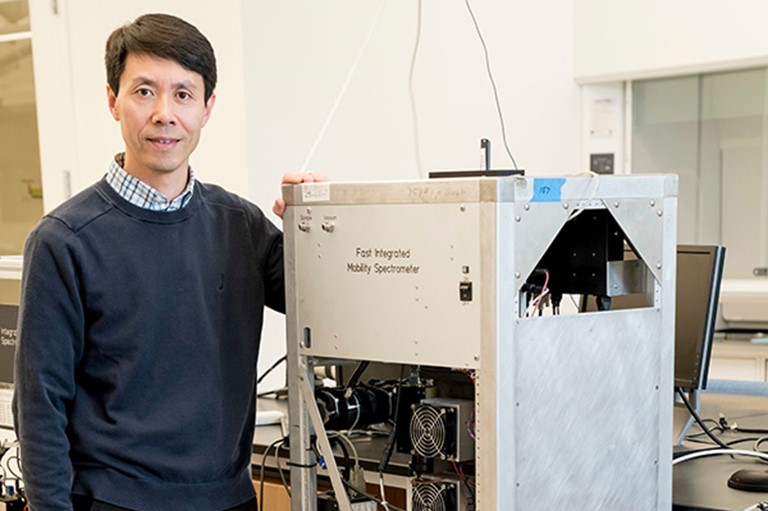
John H. Seinfeld created the first mathematical model of air quality and later identified aerosols as a neglected piece of the air pollution and climate puzzles. Richard C. Flagan, along with Seinfeld, co-developed a first-of-its-kind atmospheric chamber for studying gases and particles.
Wang’s eventual dissertation was on aerosol instrumentation and the optical properties of aerosol particles.
Instruments, Patents, and Big Impacts
While at Caltech, Wang was involved in instrument development―in particular a fast-mixing condensation nucleus counter. The prototype device, now commercialized, led to Wang’s first patent. Today, he holds four.
In 2002, Wang started at Brookhaven National Laboratory on Long Island as a Goldhaber Distinguished Fellow. He fondly recalls his early-career mentors, including senior scientist emeritus Steven Schwartz. He left in 2018 to start a research group at Washington University in St. Louis.
As for life outside science:
Lithe and lean, Wang has played badminton since boyhood. It’s a fast and subtle game, like kinetic chess on a giant board.
With racquets that weigh just ounces, players volley with a shuttlecock, or birdie. This flared, high-drag projectile, even when hit hard, pauses floatingly in the air―suspended, and vibrating with a contained vitality.
Just as an aerosol might.
From graduate school onward, Wang embraced these tiny, complex particles as not only “cool” but consequential.
Answering their mysteries could improve “air quality, human health, and climate,” he says. “Aerosols have a really big impact.”
# # #Author: Corydon Ireland, Science Writer, Pacific Northwest National Laboratory
This work was supported by the U.S. Department of Energy’s Office of Science, through the Biological and Environmental Research program as part of the Atmospheric System Research program.

